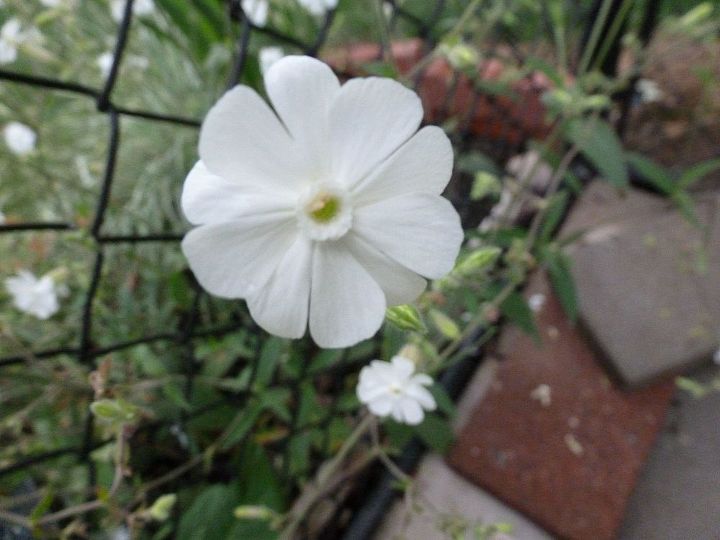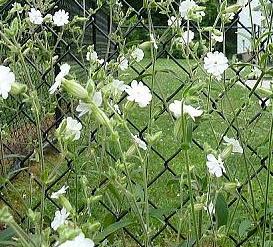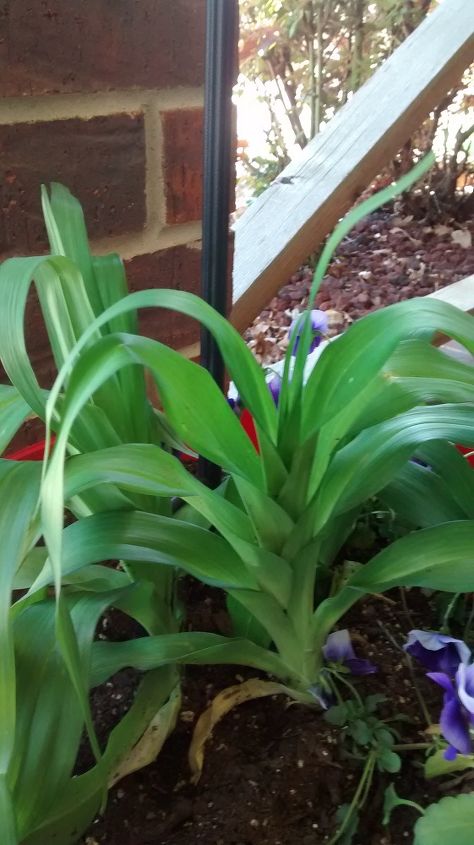Please help identify this plant.
-
Pat, where are you? It would help to know where this plant is growing.
 Douglas Hunt
on Jul 03, 2013
Helpful Reply
Douglas Hunt
on Jul 03, 2013
Helpful Reply -
-
New York - 20 min north of NYC
 Pat C
on Jul 03, 2013
Helpful Reply
Pat C
on Jul 03, 2013
Helpful Reply -
-
White Campion (Silene latifolia)
 360 Sod (Donna Dixson)
on Jul 03, 2013
Helpful Reply
360 Sod (Donna Dixson)
on Jul 03, 2013
Helpful Reply -
-
I think Donna is right - campion is my first thought - I have a deep pink one that has exactly the same foliage and flower shape.
 Heather (New House New Home)
on Jul 05, 2013
Helpful Reply
Heather (New House New Home)
on Jul 05, 2013
Helpful Reply -
-
I am in upstate NY, near Rochester, and it grows all over around here...I think it's a native "weed", at least it's pretty!
 Christine Wyffels-Rader
on Jul 05, 2013
Helpful Reply
Christine Wyffels-Rader
on Jul 05, 2013
Helpful Reply -
-
The line between weed and wildflower is in the eye of the beholder.
 Lori J
on Jul 05, 2013
Helpful Reply
Lori J
on Jul 05, 2013
Helpful Reply -
-
A weed is just a wildflower growing in the wrong place. May all your weeds be wildflowers!
 Kat
on Jul 05, 2013
Helpful Reply
Kat
on Jul 05, 2013
Helpful Reply -
-
Sorry this is a weed
 Carole Crawford-Evon
on Jul 05, 2013
Helpful Reply
Carole Crawford-Evon
on Jul 05, 2013
Helpful Reply -
-
and a pretty weed at that!
 Tracey T
on Jul 05, 2013
Helpful Reply
Tracey T
on Jul 05, 2013
Helpful Reply -
-
I believe you have rose campion which can bloom in white or pink. In some areas it is quite aggressive. Here's a link about it http://wimastergardener.org/?q=RoseCampion
 Barb Rosen
on Jul 05, 2013
Helpful Reply
Barb Rosen
on Jul 05, 2013
Helpful Reply -
-
I love white flowers...would you be willing to share some seeds?
 Deborah Kay-Morgan
on Jul 05, 2013
Helpful Reply
Deborah Kay-Morgan
on Jul 05, 2013
Helpful Reply -
-
I live in Ontario Canada and we have a weed here that I unfortunately don't know the name of. It looks just like your flower. My belief is though that if you like it in your garden, than it is a flower not a weed. Lord know there are enough "flowers" that become invasive like weeds. Enjoy your garden.
 Brenda De Lair
on Jul 05, 2013
Helpful Reply
Brenda De Lair
on Jul 05, 2013
Helpful Reply -
-
The foliage isn't right for campion.
 Brenda De Lair
on Jul 05, 2013
Helpful Reply
Brenda De Lair
on Jul 05, 2013
Helpful Reply -
-
BINGO Donna! evening lychnis/white campion, let's call it a wild flower opposed to a weed!! There's another that's similar, "bladder campion" but the flower fronts are not as nice as this one.
 Peg
on Jul 05, 2013
Helpful Reply
Peg
on Jul 05, 2013
Helpful Reply -
-
White Campion had one sprout in our garden this year so glad we decided to wait and see what it was. As soon as it flowered I got out my wildflower book and there it was. Have only one but it has been blooming for weeks. I moved it out of the garden to a flower bed and it transplanted very good.
 Cindy tustin
on Jul 05, 2013
Helpful Reply
Cindy tustin
on Jul 05, 2013
Helpful Reply -
-
If you study botany you will find that perennials are a weed somewhere or a cross of weeds. And yes weed or flower is in the eye of the beholder. for me anytthing that blooms is a flower and yes maybe I will have to control it or maybe i can find a spot and let it do its thing.
 Cindy tustin
on Jul 05, 2013
Helpful Reply
Cindy tustin
on Jul 05, 2013
Helpful Reply -
-
According to the link Barb Rosen put on here, it doesn't look like the Campion to me. It looks more like in the daisey family....it has more clean and rounded edges than the picture of the Campion on Barbs link......
 Cherie Wallace
on Jul 05, 2013
Helpful Reply
Cherie Wallace
on Jul 05, 2013
Helpful Reply -
-
there are several kinds of campion, and i've found that the leaf structure changes from it's early stages to the mature plant. i am plagued by the stuff and root it out as much as i'm able but it's been impossible to get rid of. wild mint is my other nemesis.
 Jeannette House
on Jul 05, 2013
Helpful Reply
Jeannette House
on Jul 05, 2013
Helpful Reply -
-
@Cherie Wallace , take a look at this one http://www.aphotoflora.com/d_silene_latifolia_white_campion.html
 360 Sod (Donna Dixson)
on Jul 05, 2013
Helpful Reply
360 Sod (Donna Dixson)
on Jul 05, 2013
Helpful Reply -
-
It is definitely from the genus silene, there are 5 petals deeply cleft for at least 1/4 of their length. Hard to say if L. alba (they open on the evening) or a S. cucubalatus, S. noctiflora flowers are smaller (3/4" wide). It can be a L. Dioica if flower have some rose-colored and open in the morning. Good luck on the ID.
 The French Gardener
on Jul 05, 2013
Helpful Reply
The French Gardener
on Jul 05, 2013
Helpful Reply -
-
White Campion...here are some pictures for comparison: https://www.google.com/search?q=silene+latifolia+ssp+alba&tbm=isch&tbo=u&source=univ&sa=X&ei=OpfXUbXONqyIigLP7IGQAg&ved=0CIcBEIke&biw=1024&bih=650
 Judy
on Jul 05, 2013
Helpful Reply
Judy
on Jul 05, 2013
Helpful Reply -
-
I too think that sometimes a flower is a weed is a flower, and is welcome... however, some weeds are really Weeds, like the English ivy seen all over the place in central and Southern California, the Vinca major, and the many grass weeds brought in accidentally with cattle feeds... to name but a few. What we consider a true Weed, is generally something not native to the area, and spreads aggressively either by seeds, broken plant parts, or by root structures, and it is hard to control or eradicate. One real issue is when these pretty invaders come into an area, they crowd out the native plants, which in turn changes the composition and timing of food sources to the native critters, and eventually can be attributed with changing, say a woodland meadow, into a woodland monoculture, one that doesn't feed the butterflies, bees, field mice, moles and voles, and the worms in the soil, the birds of prey, and even the soil itself can change major attributes like pH... which affects the beneficial microbes... causing those creatures which are perfectly evolved for that woodland meadow to wither and die, or starve, or move on seeking a more hospitable home. All of this major usurping of land and habitat goes on right under our unsuspecting feet... or in the treetops, or in the watersource running through the ground under this woodland area. It is not always easy for us to recognize these epic battles, however, when we do become alerted to the plight of so many species suffering and losing a long fought battle, we are reminded that every action has implications that ripple outward, seen or unseen, some good, some not so good. I am not commenting on this particular plant, nor certainly I am not criticizing the choices of gardeners from Kansas to Ontario! I just wanted to put it out there that weeds, when studied and formally designated as weeds, are really Weeds - with a capital W! Especially considering the people doing the studies are plant-lover's and flower-appreciators from all walks of life, people who would much prefer to declare a species as beneficial and welcome, than to tell everyone that the pervasive and pretty thistle is not good for our monarchs, and must be eradicated! Hopefully, we shall all become aware of, and concerned about, controlling those things we can control when it comes to our impact on our mother earth. Thanks for letting me lecture/ramble on! Consider it Food For Thought, and not a scolding!
 Maggie Lais
on Jul 06, 2013
Helpful Reply
Maggie Lais
on Jul 06, 2013
Helpful Reply -
Related Discussions
GNATS - How to get rid of them?
Somehow my house and garden got tiny gnats that killed my fuchsia plant and fly everywhere. I have tried ALL the Web recommendations - soap and oil dishes, sand in th... See more
Marigolds growing! Should I pinch the buds?
My marigold plants are growing. I heard that pinching the buds until Autumn will allow them to grow without killing the plant. Is this true?
Growing garlic
Growing our first garlic, should we wait until the leaves are drying out before we pick it? Husband picked first one today along with our first potatoes.
How to keep mice out of your garden?
Hi everyone, I have mice in my garden destroying my vegetables and I have also noticed them in the barn and shed. Please can someone tell me how to prevent them from ... See more
What's the best flower/plant to grow in Texas?
I know that opinions vary, but what's your opinion?!I have great luck w Rosemary plants. Green all year long.
Could You Please Help Me Identify This Shrub?
This has small tear drop type leaves and grows pretty pink flowers that turns brown and fall off. A few years ago, I began a garden partly due to boredom and the ot... See more
Help me identify this plant
This plant came from an old flower bed at my sisters. We dug them up when they were small. She thought she had lillies in that bed. But this doesn't look like anythin... See more







